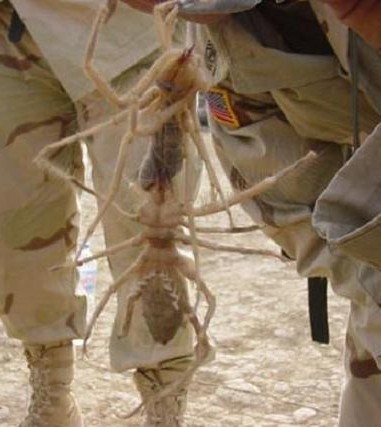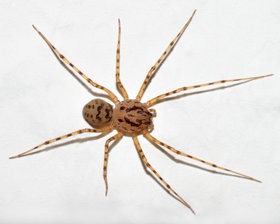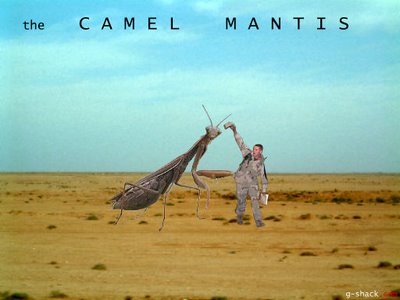Camel Spiders and Other Alleged Giant Spiders
Posted by: Loren Coleman on November 11th, 2010
From 2006…one of our most popular postings…with more comments from 2008…

Camel spiders found during the Iraq war. They are real. What do I mean by real?
Jeremy Miller was hunting black widow spiders in a Madagascar forest last winter (of 2005) when he came upon a curious fist-size web made of leaves, branches and debris woven together with thin, tough strands of spider silk. No black widow ever made such a web, but when Miller examined the tiny creatures inside, he realized he’d discovered a new species of “spitting spider.”
Thus begins the article in the San Francisco Chronicle of July 22, 2006, on the exciting find of a new animal, a spitting spider, Scytodes specialis.

Pictured above is the new species’ relative, another spitting spider, Scytodes thoracia.
Of course, finding new insects and spiders happens all the time. But my internal definition of cryptid, especially as captured in Cryptozoology A to Z, is that cryptids are big enough to visually have an impact on humans. Thus, when I read about new little spiders, it makes me wonder…what stories are out there about truly giant spiders?
Bizarrely, the war in Iraq is generating such stories. It seems soldiers have been seeing and killing “spiders” they call “camel spiders.” At the top of this posting is a photograph of two camel spiders that has been circulated a great deal on the internet.
Here’s what is being posted across cyberspace about these giant Iraqi camel spiders, so-called because they are said to jump on camels’ stomachs and lay their eggs inside for hatching:
Some facts about those giant spiders: They run 10 mph, jump three feet, are a nocturnal spider, so only come out at night unless they are in shade. When they bite you, you are injected with Novocain so you go numb instantly. You don’t even know you are bitten when you are sleeping, so you wake up with part of your leg or arm missing because it has been gnawing on it all night long. If you are walking around and you bump something that is casting a shadow over it, and the sun makes contact with it, you better run. It will instantly run for your shadow, and scream the whole time it is chasing you. PS. These are Spiders found daily in Iraq by troops. Imagine waking up and seeing one of these in your tent!! Spread this to all your friends who have a family member in the army, and let them know what kind of daily life they live everyday! Hopefully someone high in our government will start thinking about our troops’ lives, and they’ll be back home safe real soon!
Facts? Nope. Eggs in camels’ stomachs? Never.

The above camel spider factoids are myth, mixed in with one real photograph of two real arachnids (at the very top of this posting) and a few hoaxed ones (directly above). These animals are technically what are called solifugids, but are more commonly known as wind or sun scorpions or camel spiders. The eight-legged solifugids have no venom glands, and the largest species is no more than 6 inches long with its legs outstretched. Apparently, some people even keep them as pets. You can read more about them in this National Geographic article, which also talks about a new species of wind scorpion recently discovered in Mexico.
Classically, the most exotic Giant Spider sightings have come from Africa. Various Mokele-mbembe expedition members have brought back tales from the Congo of Giant African Spiders, known among the Baka pygmies, and said to be at least 10 inches across. Some are vague tales of missionaries knowing about porters being killed by giant spiders. Others tell of the giant spiders being reported under tents, crossing trails, and running through campsites. For everyone that was thinking about going on a Mokele-mbembe trek soon, they didn’t tell you about that, did they?
Perhaps most well-known is one clear story of the really large ground-dwelling spider collected by Mokele-mbembe researcher Bill Gibbons, who writes:
I first became aware of a giant ground-dwelling spider through Miss Margaret Lloyd, formerly of Rhodesia and now living in England. Her parents, Reginald and Margurite Lloyd were exploring the interior of the old Belgian Congo in 1938 when they spotted something crossing the jungle track ahead of them. At first they took the object to be a large jungle cat or a monkey on all fours. When they stopped their vehicle (an old Ford truck) to allow the animal to pass, they were thunderstruck to see that it was a very large brown spider, similar in its appearance to a tarantula, with a leg span of at least four or five feet. Mr. Lloyd trembled so much with excitement that he was unable to retrieve his camera in time to take a snap, and Mrs. Lloyd was so distraught that she wanted to return home (Rhodesia) immediately. This creature is known as the J’ba Fofi; J’ba meaning “great” or “giant” Fofi meaning “spider” (spiders of all kinds are called Fofi).
Are there other historical or contemporary Giant Spider sightings from Africa?
Cryptomundo correspondent Todd Partain writes with this new old sighting, collected during July 2006:
Just a couple of days ago, my own father related this story from his childhood, and I immediately grabbed a notebook and started jotting down facts….
One cool night in 1948, in Leesville, Louisiana, 48-year-old William Slaydon walked his wife, Pearl, and his three grandsons to church. Among them was the youngest, Richard Partain, a child of six at the time. They walked north along Highway 171, and as the road began to dip, Grandpa Slaydon suddenly stopped his grandchildren with a gesture and had them step back quietly and freeze.
The grandchildren, aged six to thirteen, knew instinctively to obey this gesture without question. There was a rustling from the ditch, and an unbelievable creature emerged from the darkness.
Richard Partain described: “It was a huge spider, the size of a washtub. It was hairy and black. No one, not even my grandmother, said a word.”
As they watched, the giant arachnid crossed the asphalt from East to West, and disappeared into the brush on the opposite side of the highway.
“We asked Grandpa what it was, and he said simply that it was a very large spider.”
Afterwards, all nighttime walks by the family to the church were cancelled. The incident was never discussed again with the grandchildren.
“Through my whole life, whenever I watched a TV program or read an article about spiders, I would wait for someone to identify it, but no one ever has,” said Richard. “I always had the impression that Grandpa was familiar with them, that had seen one before, or at least knew about them.”
Bill Slaydon, born on the turn of the century, was a man that had lived in the deep woods, building makeshift slab towns at whatever spot was necessary to facilitate the logging industry of the time. It’s likely that were quite a few anomalies the loggers were tight lipped about, especially around the kids.
What was seen in Louisiana in 1948? An escapee from a banana boat or an unidentified and unknown new species?
The goliath bird-eating tarantula (Theraphosa blondi) from Surinam, Guyana, French Guiana, Venezuela, and Brazil use to be said to be the world’s largest species. Today, the pinkfoot goliath tarantula (Theraphosa apophysis), which was discovered 187 years after the goliath birdeater, takes the prize in size. Some of these have legspans of up to 13 inches long. The males of most tarantulas are longer legged than the females.
Are larger ones to be found?
Are there new species of spiders out there that are bigger than dinner plates or a washtub?
+++
The comments below are from the original 2006 and 2008 postings, and have been retained for discussion purposes.
About Loren Coleman
Loren Coleman is one of the world’s leading cryptozoologists, some say “the” leading living cryptozoologist. Certainly, he is acknowledged as the current living American researcher and writer who has most popularized cryptozoology in the late 20th and early 21st centuries.
Starting his fieldwork and investigations in 1960, after traveling and trekking extensively in pursuit of cryptozoological mysteries, Coleman began writing to share his experiences in 1969. An honorary member of Ivan T. Sanderson’s Society for the Investigation of the Unexplained in the 1970s, Coleman has been bestowed with similar honorary memberships of the North Idaho College Cryptozoology Club in 1983, and in subsequent years, that of the British Columbia Scientific Cryptozoology Club, CryptoSafari International, and other international organizations. He was also a Life Member and Benefactor of the International Society of Cryptozoology (now-defunct).
Loren Coleman’s daily blog, as a member of the Cryptomundo Team, served as an ongoing avenue of communication for the ever-growing body of cryptozoo news from 2005 through 2013. He returned as an infrequent contributor beginning Halloween week of 2015.
Coleman is the founder in 2003, and current director of the International Cryptozoology Museum in Portland, Maine.











EasternIowa, come spring, catch one of those millipedes and be prepared to catch or preserve the squished body of one of those spiders. Maybe offer a very small reward. I bet the correspondent in Colorado would be interested.
I think that it would be very easy to mistake a big land crab for a giant spider. On the other hand, land crabs are arthropods too, and if a giant land crab with a body a foot across can exist, why not a giant spider? The term “giant” meaning, say, cat-sized) I don’t think it’s physiologically possible for any land-dwelling arthropod to be much bigger than that, but if a spider’s body was cat-sized, its legspan could conceivably be two feet or so.
No fan of spiders here but I’m not particularly afraid of them either.
I don’t have any spider stories to share but I think it is important to point out the many personal experiences shared in this column by those who have encountered spiders (as well as other insects) of incredibly large size! I mean, we often accept the friend of a friend’s account about bigfoot, and we have here people who have witnessed first hand giant spiders! I realize and appreciate the argument that limit the size of such creatures and I don’t discount them, but are we absolutely sure that such creatures, no matter how improbable, cannot exist? Is it possible that some unknown biological adaptation might allow a spider to grow to such a large size? Spiders are, after all, one of the most successful species ever created, perhaps we should not too quickly dismiss such eyewitness descriptions?
Giant spiders are possible, one can argue based on current knowledge of spider mechanics that its impossible, but if the animal is real and unknown then the argument is moot. I agree that an arachnid in its currently known physical layout would be impossibly unwieldy at say anything over 18″-24″.
However,the discussion isn’t really arguing that, from what I understand the topic is about a giant spider that is yet unclassified, perhaps we could discuss how a spider could reach those lengths with adaptation and what that the most likely adaptations or changes in body structure that would entail. That would be insightful.
Anyhoo, on cryptozoology.com William J. Gibbons is quoted as saying (from his expedition report from the congo in search of Mokele Mbembe):
“In 1938, Mr. & Mrs. R.K. Lloyd of London, England were driving along a forest road in the former Belgian Congo, when they became aware of a large animate object moving across the road ahead of them. At first they took the object to be a large monkey or jungle cat. However, as they approached the creature, the Lloyd’s curiosity turned to horror as they came face-to-face with a gigantic brown spider. Mr. Lloyd attempted unsuccessfully to retrieve his camera as the giant arachnid simply walked into the forest and disappeared. On this third expedition to Equatorial Africa, I (Gibbons) took the opportunity to enquire if the pygmies knew of such a creature, and indeed they did! The Baka word for spider is Fofi (pronounced foo fee), and Jba means ‘great.’ They speak of the Jba Fofi, which is a ‘giant’ or ‘great spider’. They described a spider that is generally brown in color with a purple abdomen. They grow to quite an enormous size with a leg span of at least five feet. The giant arachnids weave together a lair made of leaves similar in shape to a traditional pygmy hut, and spin a circular web (said to be very strong) between two trees with a strand stretched across a game trail. These giant ground-dwelling spiders prey on the diminutive forest antelope (duiker), birds, and other small game, and are said to be extremely dangerous, not to mention highly venomous. The spiders are said to lay white, peanut-sized eggs in a cluster, and the pygmies give them a wide birth when encountered, but have killed them in the past. The giant spiders were once very common but are now a rare sight. Their dwindling numbers are blamed on the continuing deforestation of their habitat, but they are still encountered from time to time. The Baka chief, Timbo, casually mentioned to us that a giant spider had taken up residence in the forest just behind his village in November 2000, when I (Gibbons) and Dave Woetzel from New Hampshire had visited him! He did not think that we would have been interested in the creature as our interest was focused on Mokele-mbembe at the time! Valuable evidence had eluded us.”
I have heard that the louisiana spider doesn’t exist, but the J’ba Fofi (congo spider) does in fact exist, and reaches size of about 10 feet.
I think giant spiders are possible because of two exteremely large spiders I have seen where I live, and I have witnesses that can back me up. I am from eastern Maryland and when I was out in the woods once years ago, I kicked over a hollowed out dead and rotted tree trunk, and out from the center came a spider that I never had seen or seen since, it may have been a new species for all I know, but it was perfectly camoflauged with the color of the rotted wood, and wasn’t noticeable until it ran past my boot, but I got a real good look at it as it stopped for a minute and so did two buddies that were there with me. It was about 6 inches from my boot, and it was larger than the boot I was wearing, and I wear a size 12. It wasn’t heavy built like a tarantula, but its legspan was huge for a spider, it was about 15 inches, we tried to catch it but it was as quick as lightning. I know some will think this is impossible for around here, but I know what I saw, we still talk about that spider almost 20 years later. I also once captured a wolf spider that was really big, I measured it and it came in at about 10 inches, I found it living under a piece of plywood, Im not sure if this is common but its the biggest wolf spider I ever saw.
A wolf spider 10″ across would be a Guinness World Record and would be the largest wolf spider in the world! A specimen of a spider which was that size would be worth a fair amount of money to science, dead or alive! As far as reports of “giant” arachnids in the rainforested areas of the globe it is entirely possible for them to exist, regardless of arguments to the contrary! The current oxygen level of our atmosphere is thought to limit the size of fauna with exoskeletons due to an inability to absorb the quantity of oxygen which would be necessary for an animal of that size to survive? However, when we look at nature and see the incredible diversity of adaptation manifested by lifeforms here on earth we cannot simply discount the possibility of some type of adaptation which has allowed for the survival of a giant species of arachnid into modern times? While I would be loathe to encounter a spider the size of a dog or larger while trekking through the rainforest, it would still be fascinating nevertheless!
hey i saw a huge spider not but a few hours ago..
actually i got on the computer to identify it and ended up on this site and made an account just to share this..
i live in southern louisiana, lafayette louisiana to be exact, i went in my backyard to cut my grass when i noticed a giant yellow web over a meter wide connecting my shed, my fence, and a tree. i checked it out for a while pretty amazed at it but didnt see a spider. I reached up and touched one of the thicker strands and noticed it was ridiculously strong. so i went in my shed, grabbed my hedge trimmers and cut a branch ab a 1/2 inch thick that had some web connected to it. the strands actually caught the branch and it just swung back and forth. then i looked up and saw what i have definately identified as a golden orb weaver spider with a leg span larger than my hand just sitting in a patch of leaves on one of the branches. it was actually quite beautiful, bright yellow and white with some red on it’s legs. I tried to take a picture of it with my phone but the only angle that didnt require me to stand directly beneath had the sun directly behind it and they wouldnt come out right..
it was then time to cut the grass so i grabbed my shovel out of the shed and knocked him out his web. This spider actually made a pretty loud thump when it hit the ground. at this point i got scared it would run at me or something and i chopped it in half with the shovel. :/ i went back later and located the tiny little male.
i promise im not blowing this up at all this spider was definately bigger than my hand and i could easily see it catching a bird in that web and it was more than big enough to eat it.
thanks
There was a giant Millipede type animal called Arthropleura that lived during the Carboniferous Period about 354 million years ago. It is estimated to have reached a size of about 2.6 meters. It lived in the coal forests along with the giant dragonfly Meganeura with a wingspan of about 75 cm. Of course smaller insects and arthropods existed at the same time, it’d just the bigger fossils are the ones that get noticed.
Some think it might have been an increase in Oxygen that caused them to grow large but not every-one agrees.
Here’s a couple of links that might be of interest.
When Giants Had Wings and 6 Legs
Atmospheric oxygen level and the evolution of insect body size
Megarachne was once thought to have been the biggest spider ever found but it has since been realised that it was a Eurypterid or Sea Scorpion. If it had been a spider it would have been quite large as it’s body estimated to be over 30cm in diameter.
Megarachne, the Giant Spider That Wasn’t
The true identity of the supposed giant fossil spider Megarachne
The Eurypterids could grow very large though.
Fossil of Biggest Bug Ever: 8 Feet Long
As far as large spiders go there are a few that are a fair size but the physics seem to be against any spider being really large unless it has evolved completely differently somehow from other spiders. It would somehow have to have an internal skeleton surely to be as large as some people are claiming.
Interesting link about some big spiders.
Nice little video clip.
The biggest spider I’ve seen had a leg span the size of my palm. This doesn’t sound like much but it is if you live in the UK.
Happy spider hunting.
Hi,
My father in law was also in the Vietnam war his 5 man unit did scout work in the jungle and were out for mints at a time. A little about my father in law I have known him for many years and have NEVER known him to lie or make up stories. He rarely talks of the war thinks it was a waste of to many American lives. While in the jungle there he swears he saw spiders with a body the size of a common dinner plate says with the legs they overall span ranged 20-30″ inches across he says he saw more than one always near creeks or water sources. Also said they scared the hell out of the entire unit they shot a few with their M16’s and unloaded full magazines and they were still moving around. Just thought I’d add this to your interesting post. I feel where there is a will life will always find a way there are living things in every environment known and unknown to man! We as mankind have only found an estimated 25% of the total spicies on this planet. So how do we know some of the spiders didn’t evolve in a different way? I will take my father in laws word as truth till someone finds one of the spiders he saw or I die witch ever may come first. Just my input I look forward to reading more of your replys.
I once saw a giant-sized spider, myself. Wouldn’t believe it, had I not been there. Didn’t believe it when told about it beforehand. Place my daughter was living was infested with wolf spiders. Tons of them, all over, swampy area in central Florida. She swore there was a giant one, and I was sure she was exaggerating the size. Then, visiting one evening, one came up from under and end table, the size of a tarantula. Clearly a wolf spider, though. I explained, “So there’s your big one!!”, and she said, “No, that’s not it.” At this point, I figured she had to be joking, then we heard a rustling sound across the room. Out from behind a stack of boxes she refused to sort (and I know why!!), up the wall, comes this enormous wolf spider! Standard shape for them, same striped, etc – didn’t look like a huntsman to me, though I know they can be found there, and a good ten inches across!! I could hardly believe my eyes. I grabbed a 2×4, and threw it, hitting this monster dead center. It not only didn’t die; it actually reared up and chittered at us!! We fled, needless to say! The person stating they saw one in another state; I believe it! Been there!! They get bigger than is accepted. I do wonder about hybrids, too – is it possible for something like a wolf spider to crossbreed with a tarantula? Maybe things just grow bigger in swamps.